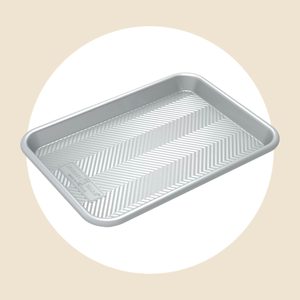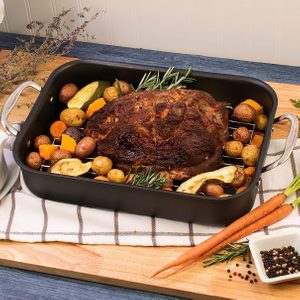How to Make Ramen
Updated: Jul. 19, 2023

The cook time might be longer than typical dinners, but once you learn how to cook ramen, this tasty pork and noodle dish will have you feeling like an at-home chef.
Thinking about changing up your usual weekend dinner rotation? Skip the takeout and learn how to make ramen. This classic pork ramen recipe serves four people and is easy to customize to anyone’s tastes. It’s one of our favorite upgraded ramen recipes.
History of Ramen
While we have lots of fun variations nowadays like spicy ramen and cheesy ramen, ramen’s origins are simple. At first a noodles-and-broth dish that Chinese tradesmen brought to Japan in the 1800s, the uncomplicated noodle dish has certainly become a distinctive and highly popular part of Asian cuisine. By the 1950s, instant ramen was on the rise in the U.S., and before we knew it, the cup of noodles became a staple in college dorms.
This meal is more than just microwaveable curly noodles in salty broth, though. True ramen is packed with bright and flavorful ingredients that differ depending on the region each variation originates from. Miso ramen, for example, is popular in the northern region of Japan. The recipe we’re making here most closely compares to a shoyu ramen, which is popular in the central region of Japan.
How to Make Homemade Ramen
Ingredients
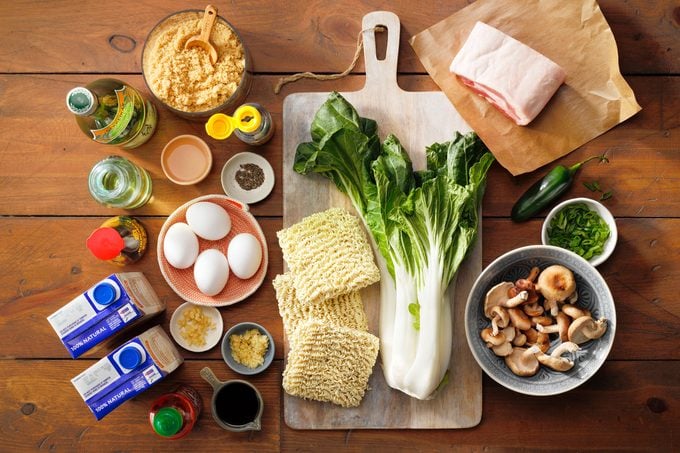
- 1 tablespoon canola oil
- 2 teaspoons sesame oil
- 1 cup sliced fresh shiitake mushrooms
- 3 garlic cloves, minced
- 1 teaspoon minced fresh gingerroot
- 8 cups chicken broth
- 3 tablespoons mirin (sweet rice wine)
- 3 tablespoons soy sauce
- 2 cups coarsely chopped bok choy
- 3 packages (3 ounces each) ramen noodles
Ramen Eggs:
- 4 large eggs, room temperature
- 1/3 cup mirin
- 1/3 cup sake
- 1/3 cup soy sauce
- 2 tablespoons brown sugar
- 2 tablespoons rice vinegar
Pork Belly:
- 1/2 pound pork belly
- 1-1/2 teaspoons canola oil
- 1/4 teaspoon pepper
Toppings:
- 2 green onions, thinly sliced
- 4 teaspoons Sriracha chili sauce
- 1/2 jalapeno pepper, sliced
Tools
- Cutting board: Our Test Kitchen used this sustainable cutting board while testing this recipe. Besides the beautiful colorways available, these boards are made out of recycled kitchen materials and renewable sugarcane.
- Shallow roasting pan: For that extra crisp texture we are aiming for with the pork belly, this shallow roasting pan will do the trick while retaining all the good flavor.
- Roasting rack: Don’t forget to place a roasting rack in your shallow pan. It will allow for an even flow of heat all around the pork belly, which will create the crisp outer skin. Learn how to make crispy pork belly.
Directions
Step 1: Boil the eggs
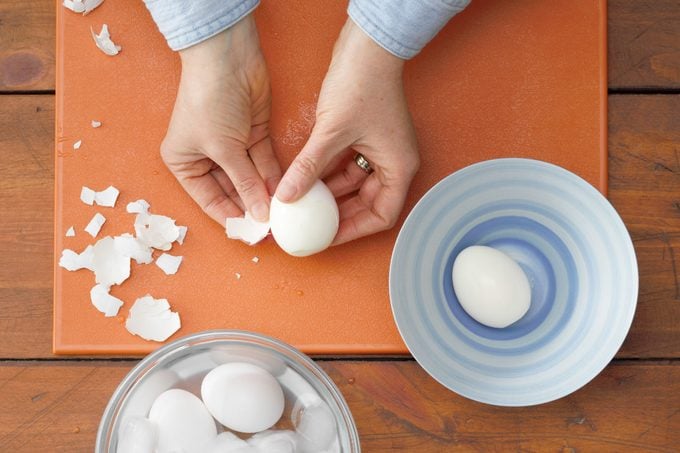
Place the eggs in a single layer in a small saucepan. Add enough cold water to cover the eggs by one inch, place the lid on the pan and quickly bring to a boil. Remove the pan from the heat. Let stand for seven minutes. Then immediately place the eggs in a bowl of ice water to cool. Once cooled, remove the shells.
Step 2: Prepare the ramen eggs
In a small bowl, whisk together mirin, sake, soy sauce, brown sugar and rice vinegar. Add the eggs and refrigerate, covered, for 24 hours or up to two days.
Step 3: Cook the pork belly
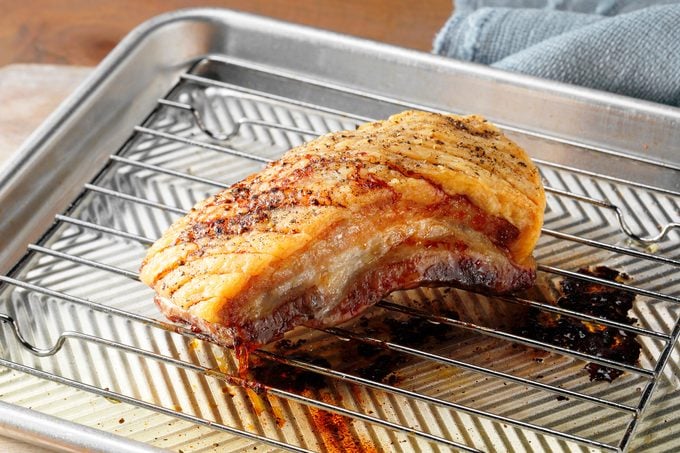
When the eggs are ready, it’s time to cook the pork belly. Preheat the oven to 350°F. Place the pork belly on a rack in a shallow roasting pan, skin side up. Using a sharp knife, score the surface of the pork with 1/4-in. deep horizontal cuts. Drizzle with oil and rub with pepper. Bake until very tender, 45-60 minutes.
Then increase the oven temperature to 425°, and roast until the skin is very crispy, 15-20 minutes longer. Let the pork stand for 10 minutes before slicing.
Step 4: Make the broth
In a Dutch oven or large saucepan, heat canola and sesame oils over medium heat. Add the mushrooms, cook and stir until tender, 3-5 minutes. Add the garlic and ginger; cook and stir for another minute. Stir in the broth, mirin and soy sauce. Bring to a boil, then reduce the heat, cover, and simmer for 10 minutes.
Step 5: Add the bok choy
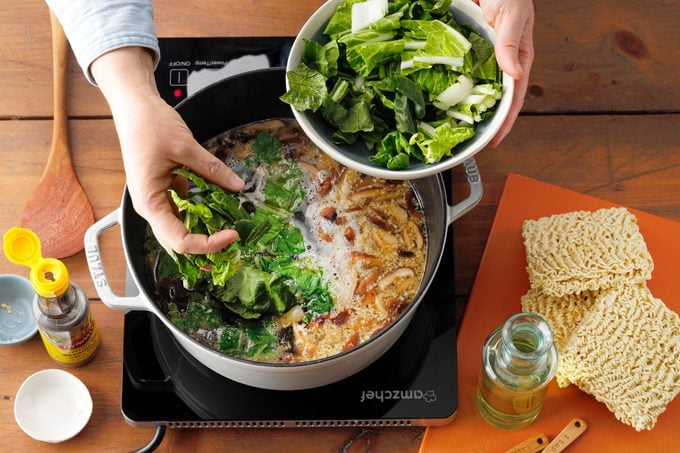
Add bok choy to the broth and cook, uncovered, for another five minutes.
Step 6: Add the noodles
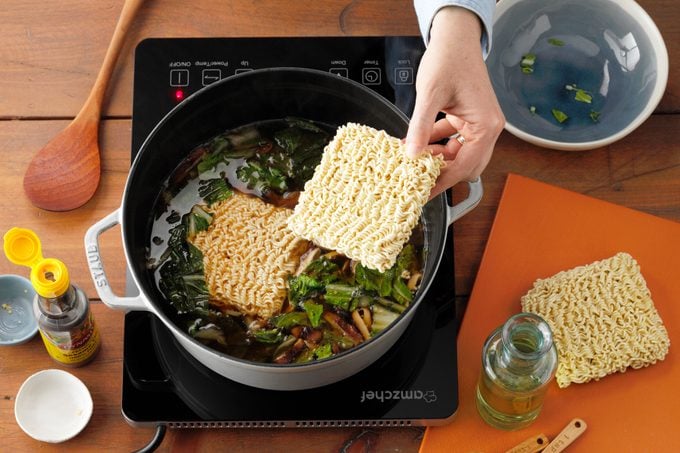
Add the noodles (discard the seasoning packets or save them for another time). Cook, uncovered, until the noodles are tender, 3-5 minutes.
Step 7: Bring the ramen together
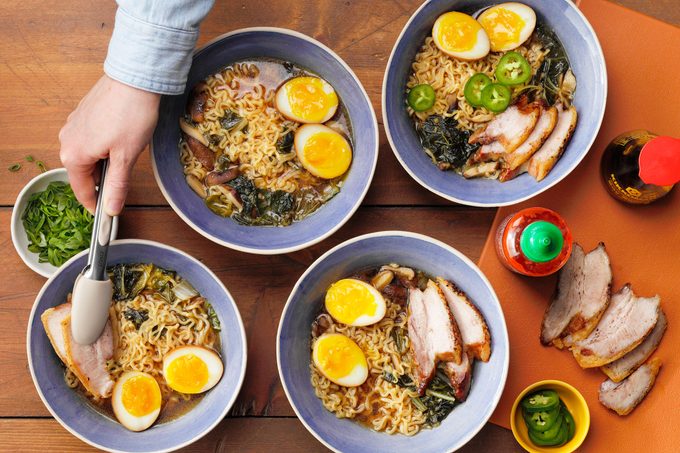
It’s finally time to add all the components together! Cut the pork belly into slices along scored lines. Remove eggs from marinade and discard the marinade. Cut the eggs in half.
To serve, add noodles, mushrooms and boy choy from the saucepan into four serving bowls. Ladle the desired amount of broth over the noodles. Top with sliced pork, eggs and toppings of your choice.
Toppings for Ramen
For our recipe, we topped the ramen with sliced green onion, Sriracha and jalapeno. If you prefer ramen with a bit less heat, try bamboo shoots, nori (sheets of seaweed cut into strips), bean sprouts or narutomaki (fish cakes).
Tips for Making Ramen
How to store homemade ramen
You can store cooked ramen in the fridge for up to three days. If you plan on keeping leftovers to eat throughout the week, keep the broth and the noodles in separate airtight containers so that the broth doesn’t make the noodles too soggy.
To keep the eggs fresh, only slice the marinated eggs in half once you’re ready to serve the ramen. This will keep them from drying out.
What are the best ramen noodles to use?
If your local grocery or supermarket sells fresh ramen noodles, that would be the best option here. Otherwise, you can always stick with dried ramen. If you’re feeling really adventurous and have some extra time, you can also try making ramen noodles from scratch!
What is the best soy sauce to use for ramen noodles?
Our Test Kitchen loves Lee Kum Kee Premium Soy Sauce, but any of these other favorite soy sauces will do. If you’re looking to cut the sodium in this recipe, opt for a lower sodium soy sauce.
Tips for assembling a bowl of ramen
We totally get it—after a long cook time, all you want to do is slop dinner together and eat! Assembling your ramen properly, though, is part of the joy of eating it. Ramen isn’t a soup you can mix together and call it a day. Instead, ramen is a noodle dish with toppings that are meant to be eaten separately.
When you place each ingredient in the bowl, make sure there is some room for noodles to show through. Pork belly can be placed on one side with the ramen egg next to it and sheets of nori popping up from under the pork. Jalapeno and green onion slices can be sprinkled over the center or around the edge of the bowl, and you can drizzle Sriracha in the center.
This assembly allows you to pull up a mouthful of noodles, let them drain, and then pick up a piece of pork or egg in the next bite. When you’re ready for some broth, dip in a ramen soup spoon.


